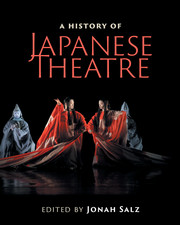Book contents
- Frontmatter
- Contents
- List of figures
- List of tables
- Contributors
- Contributors’ biographies
- Foreword
- Acknowledgments
- Note on Japanese terms
- List of abbreviations
- Timeline
- Editor's introduction
- I Traditional theatres
- Preface to Part I Japanese civilization arises
- II Modern theatres
- Preface to Part II
- III Arcs and patterns
- IV Theatre architecture
- Preface to Part IV Evolution of Japanese theatre architecture
- V Theatre criticism
- VI Intercultural influences
- Epilogue: Frozen words and mythology
- Further reading
- Index
Preface to Part IV Evolution of Japanese theatre architecture
Published online by Cambridge University Press: 05 July 2016
- Frontmatter
- Contents
- List of figures
- List of tables
- Contributors
- Contributors’ biographies
- Foreword
- Acknowledgments
- Note on Japanese terms
- List of abbreviations
- Timeline
- Editor's introduction
- I Traditional theatres
- Preface to Part I Japanese civilization arises
- II Modern theatres
- Preface to Part II
- III Arcs and patterns
- IV Theatre architecture
- Preface to Part IV Evolution of Japanese theatre architecture
- V Theatre criticism
- VI Intercultural influences
- Epilogue: Frozen words and mythology
- Further reading
- Index
Summary
Japanese performance genres share the tendency to develop their own playing space. These stages remain one of the least flexible of the many components comprising a performance; for example, indoor civic halls and commercial theatres replicate “noh stages” and “kabuki stages” to the exact dimensions of their conventional models. Some stages have developed as extensions and adaptations of the rectangular or square temple and shrine sites of their origins, while others suit the specific needs of concealing and/or displaying performers and stage technologies to their best advantage, while at the same time maintaining distinctions of spectator hierarchies through spatial differentiation. When touring domestically or overseas, traditional genres bring their own temporary structures with them in the form of backdrops or side-curtains, decorative pillars, or even a raised walkway that runs through the first-floor seats.
As part of reforms begun in the early twentieth century, new Western-style theatres were constructed, doing away with aspects of earlier theatres such as bridgeways, onstage spectators, and partitioned floor-seating. Modern straight plays and musical spectaculars were produced in purpose-built theatres based on European models. The postwar reconstruction of Japanese urban areas included integration of theatres with urban shopping and cultural centers. Angura (lit. “underground”) theatre companies adopted spaces (factories, schools, as well as sometimes literally “underground”) and temporary tents outside conventional theatres as both political and aesthetic statements. Multipurpose halls gave way to specialized theatrical spaces, a few with resident professional companies. Six distinct national theatres, some housing several halls, have been constructed in the past half-century, capable of hosting the variety of theatrical activity performed today. The following three chapters by practicing architect-scholars trace salient aspects of the trajectory of Japan's physical theatre's continuous evolution.
- Type
- Chapter
- Information
- A History of Japanese Theatre , pp. 417 - 418Publisher: Cambridge University PressPrint publication year: 2016

